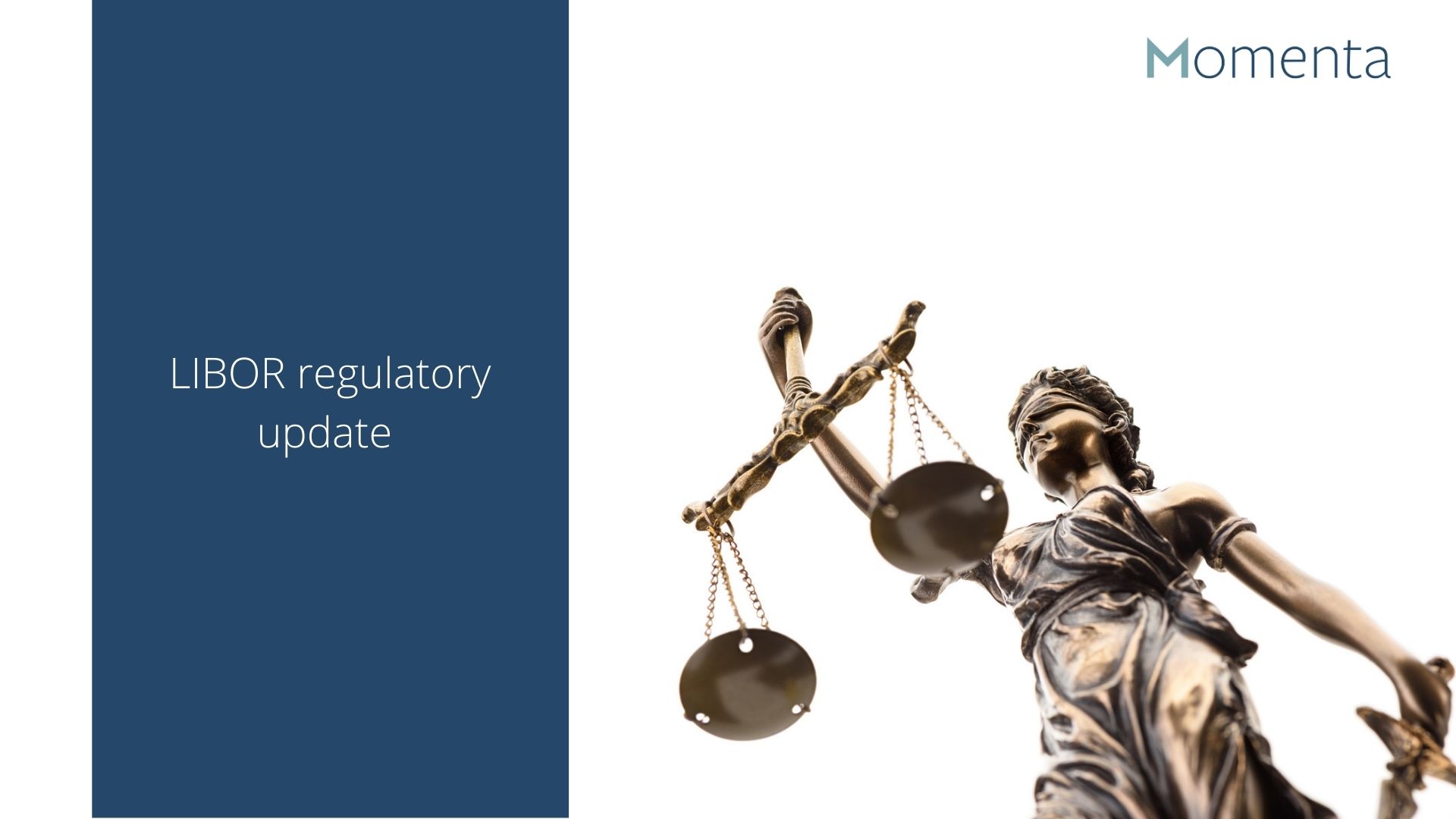LIBOR regulatory update
LIBOR regulatory updates
Policymakers and regulators have been vocal about their expectations of organisations concerning transitioning to new index rates in time. Globally they have made it exceptionally clear that it is within all market participants’ interests – from buy-side to sell-side – to ensure they are ready and prepared for the December 2021 deadline.
The next 6-8 months will be the most critical in terms of transitioning. The truth of the matter is firms can no longer delay the inevitable and must ensure that they are geared to transition away from LIBOR. With an influx of industry developments, we have compiled the latest regulations that could impact your LIBOR transition, as well as an overview of what the current state of the market looks like in terms of transition.
FCA update COVID Concerns – The deadline will not be moved
The chances are, if you work within financial services you have been impacted significantly by the pandemic, and have had to place your LIBOR transition plans to one side – either until the industry stabilises, or your firm is in a better position to cope with this change. The FCA and the PRA issued letters to banks and insurers explaining their expectations of institutions’ transitional planning for 2020 regardless of Covid-19 pressures, so if you are still thinking of reviewing your transitional plans in a few months, think again.
- The FCA has made it abundantly clear that December 2021 will remain the date by which firms will need to transition out of LIBOR exposures. Expectations include:
- Lenders should be offering non-LIBOR linked products by the end of Q3 2020, after which, all LIBOR indexed loans will need to have switch mechanisms present (SONIA or its alternative).
- All new issuance of sterling LIBOR-referencing loan products that expire after the end of 2021 should cease by the end of Q1 2021.
- Firms will need to ensure that all new issuances with LIBOR post-2021 need to comply with governance rules and that the charging structure is as clear and transparent as possible[1].
- FCA & UK Working Group on Sterling Risk-Free Reference Rates (RFR WG) and loans: A key goal for RFR WG will be to cease issuance of GBP LIBOR-based cash products maturing beyond 2021 by end Q3 2020 [2]. These will include the likes of bilateral loans, syndicated, and multi-currency products [3].
- In June the HM Treasury announced that the FCA would have additional powers in terms of managing the LIBOR transition. This means that the FCA would be able to change the methodology by which LIBOR is produced. This would be regarded as constructing a ‘synthetic’ LIBOR (this will be needed in certain circumstances) [4].
ARRC
The ARRC launched the SOFR Summer Series, a webinar series designed to educate the public on the history of LIBOR; the development and strengths of SOFR; progress made in the transition away from LIBOR to date; and how to ensure organizations are ready for the end of LIBOR [5]. The webinar was hosted by Francine Lacqua of Bloomberg, where the Governor of the Bank of England, Andrew Bailey, and the President of the New York Fed, John Williams, will discuss key issues related to the LIBOR transition.
Besides the SORF series ARRC has released the following updates and recommendations:
- Consumer Products Working Group: The group was established in 2019 to develop principles for restructuring new variable rate private student loans to account for USD LIBOR’s cessation [6]. Spread adjustment and fallback language were determined. ARCC emphasized the need for simplistic contract language in consumer products [7]. The fallback language is to reference a replacement index recommended by the Board of Governors of the Federal Reserve System, the Federal Reserve Bank of New York or a committee endorsed or convened by the Board of Governors of the Federal Reserve System or the Federal Reserve Bank of New York [8]. Should this not be a viable option, the fallback rate would be decided by the note holder, with possible adjustment to the loan’s margin to account for differences between LIBOR and its replacement. All fallback language for such products must include a “pre-cessation trigger” as well as a “permanent cessation trigger”. The ARRC has further recommended for these products a spread-adjustment to SOFR that is based on a five-year median of the historical difference between USD LIBOR and SOFR with a one-year transition period to the fixed median spread [9].
- Syndicated loans: The ARRC has revised the fallback language for syndicated loans and have released the following: the amendment approach should be rejected in favour of the hardwired approach; (2) a daily simple SOFR in arrears should be applied at the second step of the fallback waterfall; and (3) the early opt-in trigger should allow counterparties to bilaterally negotiate the trigger event if the requirement that there be at least five publicly available new or amended syndicated loan facilities referencing a SOFR-based rate is inappropriate [10].
- Spread-adjustment methodology: solve technical issues left open by its initial consultation.
- In particular, the ARRC sought feedback on two questions: (1) whether the ARRC should adopt the International Swaps and Derivatives Association (ISDA) spread-adjustment “value,” instead of its “methodology,” across the different fallback rates of the same tenor, regardless of the existence of a sufficient rate history for any given tenor; and (2) whether the ARRC should fix its spread adjustments on the same date that ISDA chooses if a pre-cessation trigger event occurs.
ISDA Protocols
All players in the derivate markets have been waiting in anticipation for ISDA to release their robust fallback protocols. These fallbacks will be critical for all players in derivatives to ensure that contracts will reference ‘clear, transparent, and consistent rates’ [11]. ISDA is extremely close to announcing the finalised protocol as well as supporting documentation that the derivate market has been patiently waiting for. The FCA has repeatedly urged market participants from all sectors – sell side, buy side, non-financial, to ensure they are ready for the end of LIBOR by adhering to the protocol that ISDA is producing. What are the key changes you will need to be aware of?
- 2006 ISDA Definitions ‘rate options’: Certain rate options will include fallbacks that would be centered around the discontinuation of LIBOR and other IBORS.
- Floating rate options: Those that use US dollar LIBOR will include fallbacks that would apply should US dollar LIBOR be terminated.
- The amendments of 2006 ISDA Definitions by publishing IBOR Fallback Supplement: Transactions occurring on or after the date of the supplement will have an amended floating rate option. Transaction supplemented before the use of the supplement will be based on the 2006 ISDA Definitions as they use to be before they were amended and therefore will not include the amended floating rate option with new fallback provision.
- Protocol to facilitate multilateral embedded – Legacy contracts: Adhering to the protocol means market participants agree that their contracts will include the amended floating rate options (relevant to the IBOR) as well as the revised fallback. These are voluntary based and will amend contracts between two adhering parties.
- Bilateral forms of amendments: These will also be created of which market participants can use to amend their legacy derivatives contracts.
Next steps
According to a survey conducted by the Investment Association of Ernst and Young 92% of firms had assessed their LIBOR exposure of which 70% have limited their exposure to LIBOR-based securities and 65% had adopted SONIA based methods [12].
For many firms, the next steps in transitioning will rely heavily on their communication plans. All counterparties, clients, and vendors will need to be contacted an educated on the LIBOR piece. Any concerns or issues will also have to be resolved as regulators will be keeping close to ensure that the best interest of the clients is met. Now more than ever firms will need to ensure that they are in a position and feel transition ‘ready’.
If you are not sure if you are as far along as you should be, set up a call with one of our team members to discuss how our resource can fasten your transition effectively and efficiently with keeping regulation and policy at the forefront of operations.

